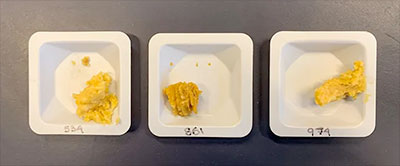|
|

|
|
Author
|
Topic: Fermenting miso on space station alters taste
|
Robert Pearlman
Editor Posts: 54363
From: Houston, TX
Registered: Nov 1999
|
 posted 04-03-2025 08:30 AM
posted 04-03-2025 08:30 AM
   
When fermented aboard the International Space Station, the Japanese condiment miso tasted nuttier than two earthbound versions, researchers report. The finding not only reveals that fermentation is possible for a food orbiting Earth, it also characterizes a space environment's influence on a food. Astronauts usually munch on freeze-dried foods void of most microbes, says industrial designer and researcher Maggie Coblentz of MIT’s Space Exploration Initiative. “Fermentation is a really exciting way to open that up, so to invite a diverse community of microbes that will interact with one another and also preserve food while growing and enhancing flavor.”A fermented food’s flavor can vary depending on the microbes and other elements of the surrounding environment. Miso was chosen for the experiment because of its firm structure, strong flavor and cultural significance, among other reasons. It represents the first known food deliberately fermented in space, says interdisciplinary food researcher Josh Evans of the Technical University of Denmark in Copenhagen.  Above: Fourteen tasters tried miso fermented in Copenhagen (left), the International Space Station (center) and Cambridge, Mass. (right). The space miso appears darker likely because of its elevated temperature aboard the ISS compared with the earthbound batches, which may have sped up the fermentation process. (Maggie Coblentz/ScienceNews) |
Liembo
Member Posts: 896
From: Bothell, WA
Registered: Jan 2013
|
 posted 04-03-2025 12:49 PM
posted 04-03-2025 12:49 PM
   
It seems strange to have such a major independent variable like temperature be a factor in this experiment. The Earth-bound samples should have been fermented at the same temperature as the ISS. At least new terrestrial samples can be fermented to match the ISS if need be. |
Robert Pearlman
Editor Posts: 54363
From: Houston, TX
Registered: Nov 1999
|
 posted 04-03-2025 01:11 PM
posted 04-03-2025 01:11 PM
   
I think the issue was that prior to flight, the logistics associated with transporting the miso to and from space, as well as the conditions on the ISS, could not be predicted such as to replicate them exactly with the control samples on Earth. As the paper notes: ...to send an experiment to space at all requires navigating a complex system of regulations and constraints that shapes how experiments can be planned and carried out. For example, transport logistics meant it was not possible for the miso mixture to stay frozen until on the ISS. It entered ambient temperature — at times possibly higher and lower than room temperature, due to heat generated by other equipment and/or cooler temperatures during shipping — when shipped from Cambridge, Massachusetts to mission control in Houston, Texas, then on to Florida for launch. And there passed some days between it leaving the ISS and being retrieved from the Pacific before being shipped back to Cambridge, when it could be returned to the freezer and the fermentation stopped.We controlled for this variability by keeping our earthbound misos in and out of the freezer for the same periods of time, and the time spent out of the freezer to a minimum. | |
Contact Us | The Source for Space History & Artifacts
Copyright 1999-2025 collectSPACE. All rights reserved.

Ultimate Bulletin Board 5.47a
|
|

|
 advertisement advertisement

|












